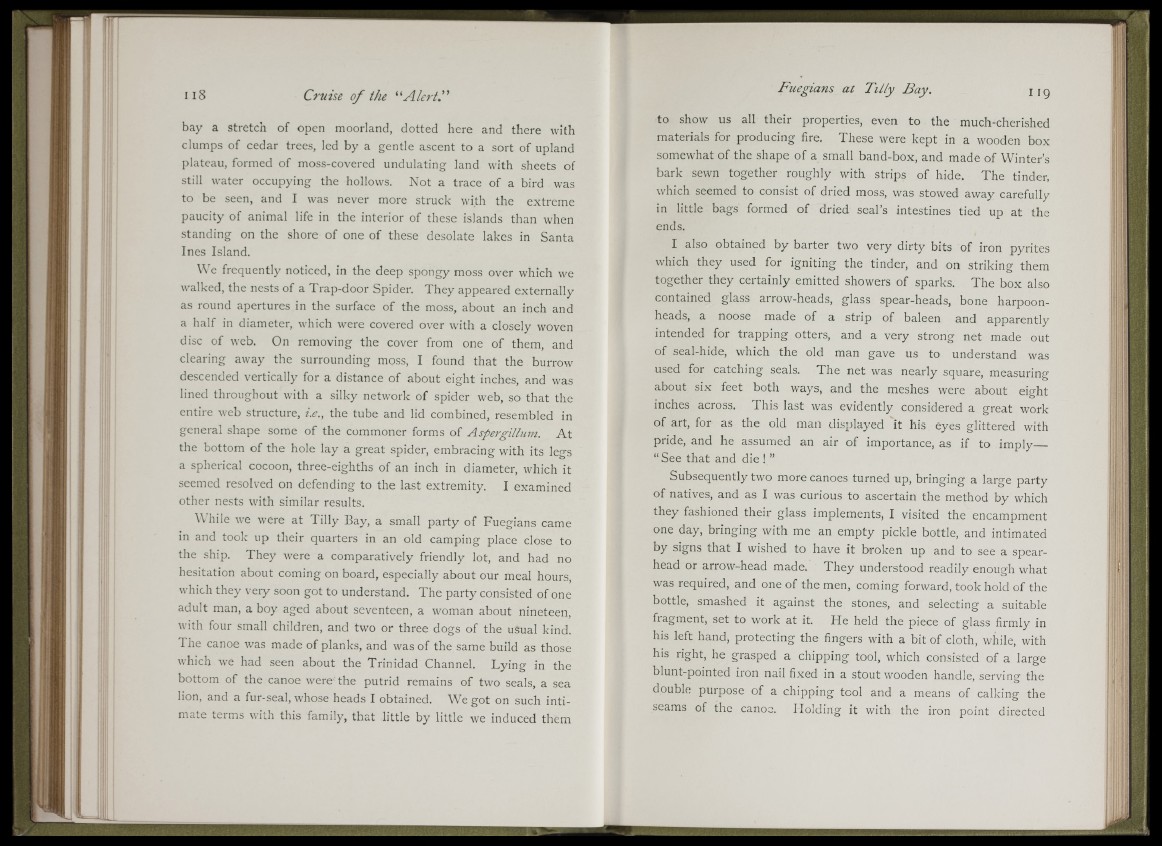
■i?«
|-r4
UB)
. ii
V«
ifI
I: ■I FI
! ?
o va 1
^ .1 i€i.
bay a stretch of open moorland, dotted here and there with
clumps of cedar trees, led by a gentle ascent to a sort of upland
plateau, formed of moss-covered undulating land with sheets of
still water occupying the hollows. Not a trace of a bird was
to be seen, and I was never more struck with the extreme
paucity of animal life in the interior of these islands than when
standing on the shore of one of these desolate lakes in Santa
Ines Island.
We frequently noticed, in the deep spongy moss over which we
walked, the nests of a Trap-door Spider. They appeared externally
as round apertures in the surface of the moss, about an inch and
a half in diameter, which were covered over with a closely woven
disc of web. On removing the cover from one of them, and
clearing away the surrounding moss, I found that the burrow
descended vertically for a distance of about eight inches, and was
lined throughout with a silky network of spider web, so that the
entire web structure, i.e., the tube and lid combined, resembled in
general shape somie of the commoner forms of Aspergillum. At
the bottom of the hole lay a great spider, embracing with its legs
a spherical cocoon, three-eighths of an inch in diameter, which it
seemed resolved on defending to the last extremity. I examined
other nests with similar results.
While we were at Tilly Bay, a small party of Fuegians came
in and took up their quarters in an old camping place close to
the ship. They were a comparatively friendly lot, and had no
hesitation about coming on board, especially about our meal hours,
which they very soon got to understand. The party consisted of one
adult man, a boy aged about seventeen, a woman about nineteen,
with four small children, and two or three dogs of the usual kind.
The canoe was made of planks, and was of the same build as those
which we had seen about the Trinidad Channel. Tying in the
bottom of the canoe were the putrid remains of two seals, a sea
lion, and a fur-seal, whose heads I obtained. We got on such intimate
teims witn this family, that little by little we induced them
to show us all their properties, even to the much-cherished
materials for producing fire. These were kept in a wooden box
somewhat of the shape of a small band-box, and made of Winter’s
bark sewn together roughly with strips of hide. The tinder,
which seemed to consist of dried moss, was stowed away carefully
in little bags formed of dried seal’s intestines tied up at the
ends.
I also obtained by barter two very dirty bits of iron pyrites
which they used for igniting the tinder, and on striking them
together they certainly emitted showers of sparks. The box also
contained glass arrow-heads, glass spear-heads, bone harpoon-
heads, a noose made of a strip of baleen and apparently
intended for trapping otters, and a very strong net made out
of seal-hide, which the old man gave us to understand was
used for catching seals. The net was nearly square, measuring
about six feet both ways, and the meshes were about eight
inches across. This last was evidently considered a great work
of art, for as the old man displayed it his eyes glittered with
pride, and he assumed an air of importance, as if to imply_
“ See that and die ! ”
Subsequently two more canoes turned up, bringing a large party
of natives, and as I was curious to ascertain the method by which
they fashioned their glass implements, I visited the encampment
one day, bringing with me an empty pickle bottle, and intimated
by signs that I wished to have it broken up and to see a spearhead
or arrow-head made. They understood readily enough what
was required, and one of the men, coming forward, took hold of the
bottle, smashed it against the stones, and selecting a suitable
fragment, set to work at it. He held the piece of glass firmly in
his left hand, protecting the fingers with a bit of cloth, while, with
his right, he grasped a chipping tool, which consisted of a large
blunt-pointed iron nail fixed in a stout wooden handle,' servinog the
double purpose of a chipping tool and a means of calking the
seams of the canoc. Holding it with the iron point directed